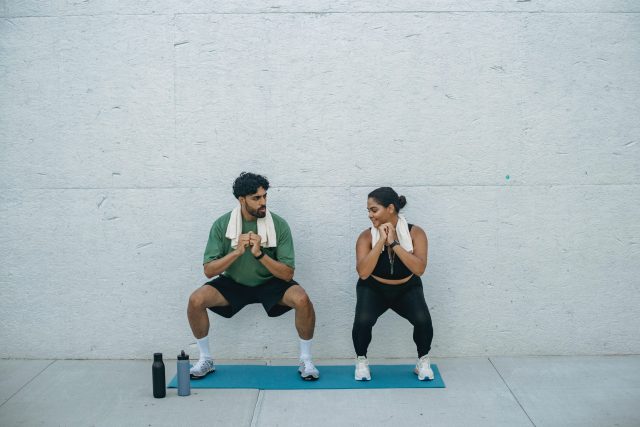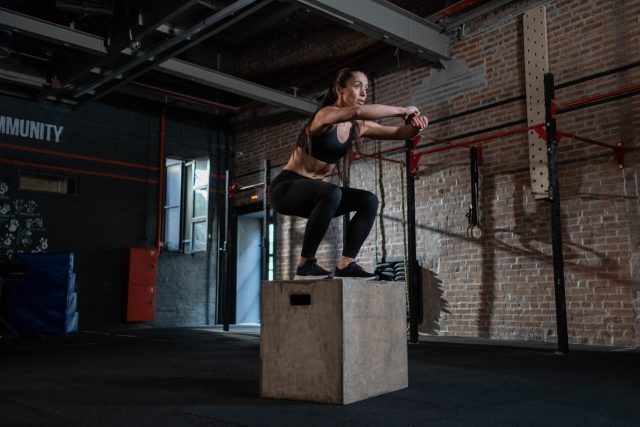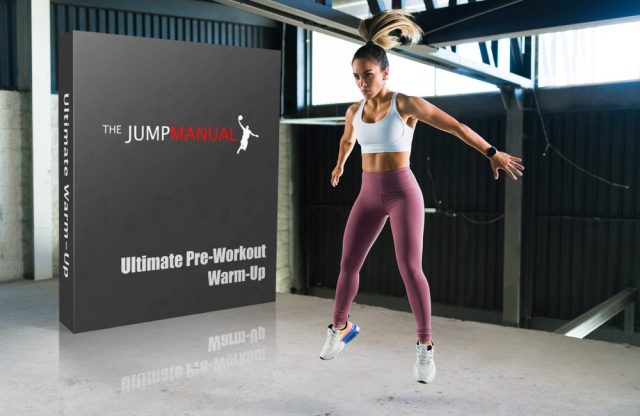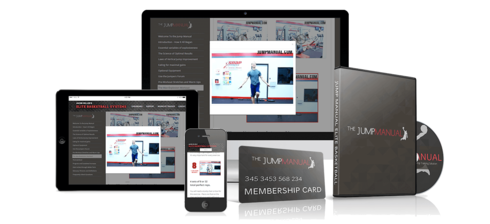How To Jump Higher By Mastering 12 Moves: Complete Guide 2024
By Vanessa Richards
January 10, 2024 • Fact checked by Dumb Little Man

There is an art to being able to jump higher, one that takes some practice. Learning how to jump higher is a goal for many athletes and weekend warriors.
Whether you’re an aspiring basketball player, football player, or just looking to improve your vertical jumps for recreation, it can be fun and incredibly effective for you.
It may take a little time for you to learn how to jump higher, but the wait is totally worth it. Just make sure you do it safely, and you can improve your jumping abilities dramatically.
It’s always fun to learn new skills especially when they can help improve our performance in sports or other activities. If you’re looking forward to learning how to jump higher, you’re in luck. In this post, we’ll share some exercises and tips that will help you get the most out of your jumps.
How To Jump Higher: What Muscles Help You Jump Higher

Jumping involves the muscles that move your legs, mainly the hip flexors, quadriceps, hamstrings, and calves. The main focus is on developing fast-twitch muscle fibers. To do this, focus on plyometric training.
Begin by doing a basic exercise and then gradually trying to jump explosively. For example, if you’re doing squats (the basic bodyweight squat), try to jump high, as much as you can, after each rep of your squat. You can also do this with smaller movements, such as lunges or step-ups.
What Are the Benefits of Jumping Higher
Want to learn how to vertical jump higher but need some motivation?
Here are some amazing benefits of jumping higher to motivate you:
- Increased vertical leap and jumping ability.
- Improved speed, agility, and overall athleticism.
- Enhanced explosiveness off the ground.
- Strength and power development in the hips, quads, and glutes.
- Better cardiovascular conditioning.
- Increased calf size and muscle mass.
- Improved balance and coordination.
- Reduced risk of injury
- More confidence on and off the playing field or court.
How to Improve Your Vertical Jump
Here are a few general tips you should remember if you want to learn how to improve your vertical jump height:
- First, make sure you’re doing the right kind of exercises; squats, lunges, and calf raises are all great exercises to improve your jumping ability.
- Next, make sure you’re doing the exercises correctly. Poor form can actually lead to injuries, which will set you back in your quest to increase your vertical jump height.
- Once you’ve got the right exercises down, it’s time to focus on your technique. This includes things like how you approach the vertical jump, how you jump off of the ground, and how you land.
- Lastly, make sure you’re giving yourself enough time to recover between workouts.
Safety Tips
You might be surprised to know that the most common injuries from vertical jump are actually ankle sprains. But that’s not the only thing you need to watch out for.
Here are some of the other injuries you might experience while improving your vertical jump height:
- Knee ligament tears
- Shin splints
- Ankle fractures
- Back strains
The good news is that all of these injuries are preventable. Jumping is a great way to get your heart rate up and torch some calories, but if you’re not careful, you can easily injure yourself.
Here are a few tips to help you avoid injuries while jumping.
- When you’re jumping, always make sure to land softly on the balls of your feet. This will help absorb the impact and protect your joints.
- Don’t try to increase your jump height too fast. Start small and work your way up incrementally. This will help prevent injuries and allow your body to get used to the motion.
- Always warm up before jumping. This will help increase your range of motion and reduce the risk of injury.
- Make sure you have good balance and control before trying any advanced jumps or maneuvers.
- Drink plenty of water before and after jumping to help reduce the risk of injury.
- Make sure you warm up properly before jumping. This will help loosen up your muscles and prepare them for the activity.
- Always jump from a safe surface. If you’re jumping on concrete, for example, make sure to jump on a surface that’s been padded or covered in rubber. And finally, don’t jump too high. Jumping too high can put unnecessary stress on your joints and increase your risk of injury.
Tips for Jumping higher
The following are some of the very beneficial tips if you want to learn how to jump higher:
Develop Your Muscles
Develop the muscles that propel you through the air. And for that, nothing beats jumping into a set of good old-fashioned trampolines. Make sure to stretch out your arms and legs every time, and don’t forget to breathe deeply as you practice.
Improve Your Coordination
Learn to coordinate your landing with your takeoff. To do that, you need to master the art of balance; try putting a ball in one hand and tossing it up and down with your other hand, making sure it doesn’t touch the ground.
Also, bowling can help you develop good balance as well as strengthen your legs. Once you feel comfortable tossing a ball back and forth, try jumping forward every time you catch it about five times in a row. When possible, try doing this on an incline (such as stairs or a grassy hill).
Stretching Exercises
Do plenty of dynamic stretching exercises to maintain flexibility and reduce the risk of injury. There are all kinds of fun stretches you can do anywhere, like walking lunges forward on your lawn or bending over backward, holding onto the arm of a chair. Be sure to stretch at least twice a day (in the morning and before bedtime).
>>Related Article: Hyperbolic Stretching Review: Does it Work?
Resistance Bands
Use resistance bands to strengthen your legs. Resistance bands will help you develop strong quadriceps and gluteus muscles, which are two of the most important muscle groups when it comes to jumping higher.
Try doing resistance band knee lifts while sitting cross-legged on the floor; if possible, get a partner to hold down your feet so that you can do this exercise without any assistance.
>>Related Article: Powerlifting Resistance Bands to Improve Your Workout
12 Exercises to Help Improve Your Vertical Jump
1. Jumping Rope

So you want to learn how to jump higher? Well, using a jump rope is a great way to start. Here are a few tips to help you get the most out of your workouts.
- First, make sure you’re using the right size rope. If it’s too big, you won’t be able to control it properly, and if it’s too small, you’ll strain your shoulders.
- Second, always keep your elbows close to your body. This will help you generate more power and increase your speed.
- Third, stay light on your feet. This will help you jump higher and stay in control of the rope.
- Fourth, focus on your jumping technique. Remember to keep your knees bent and your heels down at all times.
- And finally, don’t forget to breathe! Taking deep breaths will help you stay focused and energized throughout your workout.
2. Jumping jacks

Jumping jacks are a great way to get your heart rate up and work on your explosiveness. They also help with your cardio and overall fitness. Here’s how to do them:
- Start by standing with your feet together and your hands at your sides.
- Next, jump your feet out to the side and raise your hands above your head.
- Jump back to the starting position and repeat.
Make sure you keep your core engaged throughout the exercise and focus on explosive movements. Try to do as many jumping jacks as you can in one minute and see how you improve over time.
3. Single-leg deadlifts with jump
This exercise is great for strengthening your glutes, hamstrings, and calves—all of which are crucial for jumping higher. And you don’t need any equipment, so you can do it anywhere.
Here’s how to do it:
- Start by standing on one leg with the other leg bent behind you.
- Hinge at your hips and lower your torso towards the ground, keeping your back straight.
- When you reach the bottom of the movement, drive through your heels to lift yourself back up to the standing position.
- At the top of the movement, jump up into the air as high as you can.
- Land softly on one foot and repeat.
4. Forward linear jumps
If you’re looking to jump higher, linear jumps are a great place to start. They’re simple and straightforward, and you can do them pretty much anywhere. These exercises are pretty simple. All you need to do is jump up and move foreward at the same time. You can do them in any way you want.
5. Squat jumps

You’re probably familiar with the squat jump—it’s a great exercise for building explosive power.
Here’s how to do it:
- Start in a squat position with your feet hip-width apart, then jump up as high as you can.
- When you land, be sure to quickly transition back into a squat position.
- Repeat this movement for as many reps as you can.
6. Rebounding
Rebounding is a great exercise if you want to jump higher. When you rebound, you’re using the power of gravity to your advantage, which means you’re getting more height with less effort. Not to mention, rebounding is a great cardio workout, too.
Here are a few tips to help you get started:
- Use a rebounder that’s the right size for you. If it’s too small, you won’t get enough height; if it’s too big, you’ll lose your balance.
- Bend your knees when you jump, and keep your body upright. This will help you generate more power.
- Land on the balls of your feet, and don’t let your heels touch the ground.
- Keep your arms straight and use them for balance.
- Stay focused and stay on task. The more focused you are, the better your rebounds will be.
7. Box Jumps

- Find a sturdy box or bench that’s about 18 inches high.
- Stand in front of the box with your feet shoulder-width apart.
- With knees slightly bent, swing your arms back, then jump up onto the box, landing with both feet together.
- Jump off the box, and repeat.
8. Broad Jumps
- Stand with your feet hip-width apart, and then take a big step forward with your left foot.
- Bend your knees and jump up, swinging your arms forward to help you jump higher.
- Land with your left foot in front of your right foot, and then step back with your right foot to the starting position.
- Repeat this jumping sequence, alternating which foot you lead with.
9. Split Squat Jumps
Split Squat jumps is a great jump training exercise to help you jump higher.
Here’s how you do it:
- Stand with your feet shoulder-width apart and your hands on your hips.
- Step your left foot behind you and bend your left knee so that your thigh is parallel to the floor.
- Keeping your core engaged, jump straight up, switching legs in midair so that your right foot is now in front of you and your left foot is behind you.
- Land softly on the ball of your left foot and immediately repeat the jump, switching legs again so that your right foot is in front of you and your left foot is behind you.
- Make sure to keep your core engaged throughout the exercise to protect your spine.
10. Tuck-Ups
This is a fantasitic jump training exercise for strengthening your abdominal muscles, which will help you jump higher.
Here’s how to do it:
- Lie flat on your back on the floor and place your hands behind your head.
- Bring your knees, slightly bent, towards your chest and hold them there.
- Raise your torso up towards your knees until your upper body is parallel to the floor.
- Hold for a second, then slowly lower yourself back down to the starting position.
- Repeat 10-15 times.
11. Single-Leg Romanian Deadlifts
This is a great exercise for jumpers because it targets your hamstrings and glutes, which are essential muscles for jumping. To do a single-leg Romanian deadlift, stand on one leg and hold a weight in your other hand.
Bend at the waist and slowly lower the weight towards the ground. Keep your back straight, and make sure you’re pushing your hips backward as you lower the weight.
Once you’ve gone as low as you can, slowly lift yourself back up to the starting position. Repeat this exercise 10 times before switching to the other leg.
12. Ski Jumps
To do a ski jump, stand with your feet hip-width apart and go to a squat position. Do an arm swing forward and jump as high as you can, landing on your toes. Be sure to swing your arms back down by your sides as you jump so you can generate more power.
Comprehensive Digital Guide To Increase Your Vertical Range
Increase Power, Explosiveness, and Jumping Ability: Jump Manual Program
| Product Name | Form | Description | Price | Official Website |
|---|---|---|---|---|
The Jump Manual | Digital Program | The Jump Manual is a digital product that involves explanation videos, and workout charts. | $97 (Limited Offer Only) |  |
The Jump Manual is a perfect vertical jump training program when it comes to increasing your range. This program is based on extensive research over fifteen years and has been used by thousands of people, including professional athletes, all across the world.
This program relies on the principles of Olympic weightlifting and plyometrics. Every single exercise mentioned in this program is backed by scientific research. What makes this program so effective is that it is designed with everyone in mind.
This program can help you improve your jumping, regardless of your current athletic abilities. In fact, this program will even help you if you have difficulty walking. It will guide you in a systematic way and teach you how to improve your stamina and strength.
The Jump Manual consists of two phases:
In the first phase, you will learn a number of important exercises. These exercises are targeted especially at the lower body and limbs. These exercises will help you boost your lower body strength and thereby learn how to jump higher.
In the second phase, you will learn about diet and how you should devise your meal plans. In this phase, you will learn which foods can help you improve your athletic abilities.
How Can The Jump Manual Help You?

Developed by Jacob Hiller, The Jump Manual will teach you how to boost your energy, stamina, muscle power, and jumping techniques. It will teach you how to become a better jumper with the help of scientifically proven effective exercises, drills, nutritional guidance, and other important techniques.
Basically, you will be able to improve three things with the help of this program: your strength, power, and explosive movements. You will learn about advanced box jumps, medicine ball throws, plyometric exercises, and much more.
You will be able to improve your vertical jump, give you a proper form, enhance your stamina and power, put you in proper form, improve the health of your muscles, become more agile and quick, and boost your explosive movements and power.
Shop The Jump Manual Program at the Official Website.
Full Article: The Jump Manual Reviews 2024: Does it Really Work?
Conclusion
Jumping is a powerful athletic skill that can be used in all kinds of sports, from soccer to basketball. It allows players to propel themselves thru the air with great speed and height.
However, it’s not just for athletes. Jumping is great for everyone. There are tons of benefits to jumping. It’s good for your muscles, back, general stamina, blood circulation, and much more.
The higher your jump, the better your health. It may seem a little hard to jump higher. However, it is very much possible. If you want to improve your jumping, there are many drills and exercises that can help you.
If you are looking for a comprehensive guide about the best and most effective exercises and techniques in this regard, The Jump Manual is the best program for you. This program is the best jumping training program available online.
If you are a beginner at jumping, this program can take you to a professional level within no time.
Click Here to Get The Jump Manual Program at Discounted Price.
How To Jump Higher FAQs
Can Youg help you jump higher?
Yoga isn’t about jump training; however, it can help you improve the strength and flexibility of your muscles, which can help you jump higher.
Can you train yourself to jump higher?
Absolutely. All you need to know is essential exercises and techniques.
Can some people naturally jump higher?
Yes, some people have naturally stronger muscles compared to others and can therefore jump higher.
Vanessa Richards
Vanessa is a mom of 3 lovely children and a software geek. Outside of her career as a health and wellness instructor. She enjoys writing and researching on topics such as finance, software, health and culinary.


